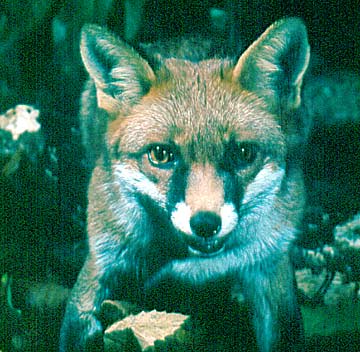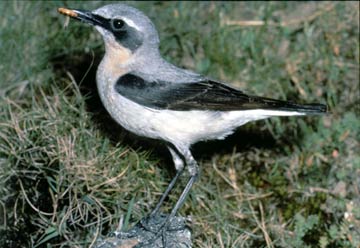Slate - Slate Ecology.
 Contrary to what one would expect, the slate areas
support a very rich ecological variety as various surveys have
shown. In 1995, Cynefin Environmental Ltd. published an
environmental statement on the Rhosydd and Conglog Quarries at
Blaenau Ffestiniog. This survey was undertaken using the standard
methodology of the Nature Consultancy Council Phase 1 habitat
survey, which is a standardised system for classifying and mapping
units of land in all parts of Britain. The habit classification
is based principally on vegetation, as it is simple to observe, identify and record, as opposed to animals, being
mainly small, fugitive and mobile are therefore more difficult to
record and use as indicators. The habitat recorded
was:- Contrary to what one would expect, the slate areas
support a very rich ecological variety as various surveys have
shown. In 1995, Cynefin Environmental Ltd. published an
environmental statement on the Rhosydd and Conglog Quarries at
Blaenau Ffestiniog. This survey was undertaken using the standard
methodology of the Nature Consultancy Council Phase 1 habitat
survey, which is a standardised system for classifying and mapping
units of land in all parts of Britain. The habit classification
is based principally on vegetation, as it is simple to observe, identify and record, as opposed to animals, being
mainly small, fugitive and mobile are therefore more difficult to
record and use as indicators. The habitat recorded
was:-
- acid grassland;
- marshy grassland;
- continuous bracken;
- acid dry dwarf shrub heath;
- wet dwarf shrub heath;
- wet dwarf shrub heath/acid grassland mosaic;
- acid flush;
- valley mire; basin mire;
|
- swamp;
- standing water (oligotrophic);
- running water (oligotrophic);
- natural rock exposure;
- slate spoil;
- buildings.
|
Plant communities
The vegetation of the area was recorded using the methodology
developed for the British National Vegetation Classification from
small representative sample areas, called quadrants.
Ornithology
Cwmorthin and surrounding the hills are particularly important
ornithologically for their upland bird population.
Bird species ranked roughly in order of interest:-
- chough;
- peregrine;

- raven;
- ring ousel;
- twite;
- buzzard;
- dunlin;
- merlin;
- wheatear;
- whinchat;
- common sandpiper;
- dipper;
- grey wagtail;
- cuckoo;
- grey heron;
- little grebe;
- goosander.
Mammalian ecology
It is likely that the palmate newts (Tritinus
helvetceuis) occur in this area as well as the common frog
(Rana temporaria). In general, though, the whole area is
likely to be too cool with too little sun for ecothermic
vertebrates like reptiles. The virtual lack of heather
(Calluna vulgaris and Erica spp) further mitigates
against, for example, the presence of adders (Vipera beris).
However, it is quite possible that grass snakes (Natrix
natrix) occur, especially in the vicinity of the lake, and
slow worms (Anguis fragilis) might be found, especially
near the ruined buildings.
The almost complete absence of trees and shrubs (except those
associated with derelict buildings which are discussed below)
mitigates against the presence of bats, except for the
Pipistrelle (Pipistrellus pipistrellus), which probably
occurs in the area. The exposed conditions are probably
unfavourable for small mammals generally. The ground is almost
certainly too wet throughout the year for hedgehogs (Erinaceus
europea), moles (Talpa europea), and rabbits
(Oryctolagus cuniculus). The only small mammal that is
likely to be common and widespread is the field vole (Microtus
afratis), with perhaps the pygmy shrew (Sorex
minutus), and common shrew (S. araneus). However, the
absence of heather means the habitat is not good for either of
the species.
The stream, nant Conglog, feeding Llyn Cwmorthin looks
suitable for the water shrew (neomys fodiens) but the
almost complete absence of cover means that the large mammals are
likely to be absent from this area, and neither the weasel
(Mustela nuralis) nor polecat (Mustela putorius)
are likely to occur in the area because of the high altitude and
the lack of trees.
Plas Cwmorthin and other built
structures
There are several built structures in the valley and in the
vicinity of Rhosydd Quarry. Plas Cwmorthin is largely roofless,
but might nevertheless provide possible sheltering sites for bat
species. There are approximately 24 mixed mature broad-leaved and
coniferous trees in its surrounds including larch (Larix
decidua), Scots pine (Pinus sylvestris), ash
(Fraxinus excelsor), sycamore (Acer pseudoplatanus)
and beech (Fagus sylvatica). Two other built sites in the
valley also have trees nearby, at the south-eastern end of Llyn
Cwmorthin and at Capel Rhosydd. Only the former is likely to
provide a significant habitat, as the chapel site has just 2 very
isolated and exposed pines.
The Plas Cwmorthin site, particularly, is a haven, an island
of shelter in an area that is generally very inhospitable for
vertebrates generally. Bat species in Great Britain, apart from
the Pipistrelle, requires trees and it impossible that conditions
at Plas Cwmorthin could meet the requirement of two or more bat
species. Furthermore, such sites with shelter from trees might
act as islands for other mammal species not found elsewhere in
the area. In particular, the bank vole (Clethrionomys
glareolus) and the wood mouse (Apodemus sylvaticus)
might occur. Some of the larger mammals mentioned elsewhere in
the statement might find havens there. At some time in the past,
all areas of human habitation would have contained populations of
house mouse (Mus domesticus) and common rat (Rattus
norvegicus), but both will now almost certainly be extinct in
the study area due to the abandonment of habitation. As well as
an unusually wooded and sheltered habitat for some mammal
species, Plas Cwmorthin especially is an island habitat in bleak
grassland for several species of bird.
The upland areas, including Rhosydd
Quarry
Generally, the bleakness of both of the semi-natural,
sheep-grazed, wet and acid grassland of the abandoned quarry
workings and buildings at Conglog and Rhosydd mean that very few
non-avian vertebrate species will be found. Fox (Vulpes vulpes)
and stoat (Mustela erminea) will, however, regularly hunt over
the high country, and these uplands lie within the Welsh range of
the nationally rare pine marten (Martes martes) which may be
found in open moorland here. It is conceivable that the old
quarry buildings and mine workings might serve as sheltering
places for one or more species of bat, although this is
considered unlikely because of the lack of trees, and high
altitude and climatic characteristics of this upland area.
Invertebrate ecology
Cwmorthin
From the southwestern end of Llyn Cwmorthin, the existing
agricultural track passes an area covered by a mosaic of wet
heath and acid grassland and further on, before the gate chain
age 520m, it bisects an extensive area of mire. The mire area,
although far from pristine due to disturbance mainly from heavy
grazing by sheep, is likely to be one of the more important
habitat types in terms of the inveterate fauna represented. A
similar but more isolated upland valley mire at Llyn Pencraig,
Caernarfon (NGR SH775585) at 295m AOD, which adjoins old lead
workings was surveyed by the NCC in 1988 as part of the Welsh
Peatland Invertebrate Survey, and the results have recently been
published. (Holmes et. Al., 1995). Although in general, the
invertebrate interest at the study area was limited, certain
nationally rare, or scarce, species could be present in the mire
habitat in the Rhosydd Quarry survey area. J. Sursumflexus is
considered to be widespread in Welsh peatlands, and the prescence
of bottle sedge at the western margin of the mire might support a
population of S. litoralis.
In terms of abundance, flies (Diptera) account for a
large proportion of the invertebrates which emerge from upland
bogs and mires. Craneflies (Tipulidae) whose larvae,
leather jackets are generally highly prone to desiccation are
particularly abundant….At the time of visiting the survey area
large numbers of Tipulidae were observed emerging from parts of
the mire and wet heath and acid grassland habitats. Populations
of upland insectivorous passerine birds, such as meadow pipits
(Anthus pratensis) and whinchats (Saxicola ruberta)
can be highly dependent upon the food source provided by the
characteristically high emergence of tipulids from acid upland
wetlands….The presence in the vicinity of the survey area of
raptors such as peregrine falcon (Falco peregrinus), which
prey upon passerines such as meadow pipits and whinchats, could
be indirectly linked to the abundance of emergent tipulids from
mires such as those near Llyn Cwmorthin.
Conglog and Rhosydd Workings
The majority of the land in both of these areas consists of
heavily grazed acid grassland. This type of habitat is probably
the most estensive in the uplands of north Wales. The
characteristic invertebrate fauna are of little or no
conservation interest. There is however, an extensive area of
inaccessible dry heath that is apparently sparsely grazed
situated on the natural rock outcrops to the east of Rhosydd
Quarry. The scarcity of well established heath in north Wales
probably renders this area of some importance. Many invertebrate
species are associated with heather or the closed canopy
heathland habitat and do not occur in more heavily grazed habits
where heather is replaced by grassland.
Twll East and Twll West
Due to adverse weather conditions at the time of the site
visit, only the extensive mire area to the north and east of y
tyllau was observed. This wetland area is considered to be of
similar importance to the mire around Llyn Cwmorthin.
|